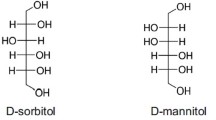Summary
The effect of adding amiloride or spironolactone to an antihypertensive regimen which consisted of hydroehlorothiazide and guanethidine was studied. Amiloride and spironolactone produced very similar effects including significant urinary sodium loss, decrease in serum bicarbonate, potassium retention and increase in serum potassium. In two groups of hypokalemic patients, neither spironolactone nor amiloride caused further lowering of blood pressure. Temporary moderate hyperkalaemia occurred in one patient when amiloride was substituted for spironolactone. The administration of the two drugs together or in close succession appears to be hazardous, probably due to synergistic effects.
Similar content being viewed by others
References
Bartorelli, C., Gargano, N., Leonetti, G.: Potassium loss and potassium replacement during long-term diuretic treatment in hypertension. Antihypertensive Therapy (F. Gross, editor), p. 422. New York: Springer 1966.
Cochran, W.G., Cox, G.M.: Experimental Designs, 2nd ed. p. 293. New York: John Wiley and Sons 1957.
Cohen, A. B.: Hyperkalemic effects of triamterene. Ann. Int. Med. 65, 521–527 (1966).
Conway, J., Leonetti, G.: Hypotensive effect of ethacrynic acid. Circulation 31, 661–664 (1965).
Cranston, W.I., Juel-Jensen, B.E.: The effects of spironolactone and chlorthalidone on arterial pressure. Lancet 1962 I, 1161–1164.
Gombos, E. A., Freis, E. D., Moghadam, A.: Effects of MK-870 in normal subjects and hypertensive patients. New Engl. J. Med. 275, 1215–1220 (1966).
Grieble, H. G., Johnston, L.C.: Treatment of arterial hypertensive disease with diuretics. Arch. intern. Med. 110, 26–33 (1962).
Heath, W. C., Freis, E. D.: Triamterene with hydrochlorothiazide in the treatment of hypertension. J. Amer. med. Ass. 186, 119–122 (1963).
Kampffmeyer, H., Conway, J.: The antihypertensive and diuretic effects of amiloride and its combination with hydrochlorothiazide. Clin. Pharmacol. Ther. 9, 350–354 (1968).
Liddle, G. W.: Specific and non-specific inhibition of mineralocorticoid activity. Metabolism 10, 1021–1030 (1961).
McNay, J.L., Oran, E.: Possible predisposition of diabetic patients to hyperkalemia following administration of a potassium retaining diuretic, Amiloride (MK 870). Metabolism. In Press.
Snedecor, G. W.: Statistical Methods, 5th ed. p. 90. Ames (Iowa): Iowa State University Press 1956.
—: Statistical Methods, 5th ed. p. 49. Ames (Iowa): Iowa State University Press 1956.
Spiekerman, R. E., Berge, K. G., Thurber,D. L., Gedge, S. W., McGuckin, W. F.: Potassium-sparing effects of triamterene in the treatment of hypertension. Circulation 34, 524–531 (1966).
Tobian, L.: Why do thiazide diuretics lower blood pressure in essential hypertension? Ann. Rev. Pharmacol. 7, 399–408 (1967).
Winer, B. W., Lubbe, W. F., Colton, T.: Antihypertensive actions of diuretics. Comparative study of an aldosterone antagonist and a thiazide, alone and together. J. Amer. med. Ass. 204, 775–779 (1968).
Wolf, R. L., Mendlowitz, M., Roboz, J., Styan, G. P. H., Kornfeld, P., Weigl, A.: Treatment of hypertension with spironolactone. J. Amer. med. Ass. 198, 1143–1149 (1966).
Author information
Authors and Affiliations
Additional information
This is contribution No. 934 from the Division of Basic Health Sciences, Emory University School of Medicine. This investigation was supported by grants HE 06491, HE 5582, GM 14270, and FR 39 from the National Institutes of Health.
Rights and permissions
About this article
Cite this article
McNay, J.L., MacCannell, K.L. & Oran, E. Potassium-retaining diuretics: Electrolyte changes induced in hypertensive patients. Pharmacol. Clin. 2, 94–98 (1970). https://doi.org/10.1007/BF00420714
Received:
Accepted:
Issue Date:
DOI: https://doi.org/10.1007/BF00420714




